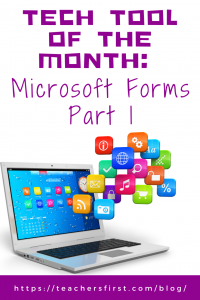Microsoft Forms is a simple web tool/app that allows you to easily create polls, quizzes, and surveys and collect real-time data. Teachers can use this tool to collect feedback from families, students, and other teachers, build quizzes, and plan class, staff, and schoolwide activities. With Forms, you can assign point values to quiz questions, add images, add YouTube videos within questions, and much more. One of the best features of Forms is that it works on any device with a web browser. You can use a URL or QR code to share your forms with participants or embed them into a website or email. A response tab on the form lets you view responses as soon as they’re submitted. You can return to existing forms as needed to review the data collected and duplicate forms to create new polls or surveys. Forms also automatically convert data into charts and graphs, making your results more functional and easier to interpret. You can even export results to Excel for additional analysis or grading. Forms are ideal activities for in-person lessons or blended/remote learning.
Applying the Triple E Framework
The Triple E Framework, created by Dr. Liz Kolb, believes that “effective technology integration begins with good instructional strategies and not fancy tools” (tripleeframework.com). Dr. Kolb wrote a book on the topic, Learning First, Technology Second (ISTE, 2017), that lays out the three main uses for technology in education: to Engage, Enhance, or Extend learning goals. We can use this framework to decipher why we use specific classroom tools. Here is a rubric based on the Triple E Framework you can use to evaluate whether Microsoft Forms (or any other technology) is a good fit with your learning goals and whether you should use it in your lesson.
- Engage in learning goals: Forms motivates students to begin learning by allowing for various question types and media (images and videos) that make the tool more engaging. Microsoft Forms has no advertisements or other distractions, helping students focus on the content.
- Enhance learning goals: Microsoft Forms creates paths for students to demonstrate their understanding of the learning goals in a way that would be impossible without technology. For example, Forms allows students to complete assessments/surveys and shows teachers class results instantly, giving them the ability to assess what needs to be retaught and to scaffold or differentiate learning.
- Extend learning goals: Dr. Kolb describes extended learning as an opportunity for students to learn, connect, and collaborate outside the regular school day and bridge the school day and real-life experiences. You can use Microsoft Forms as a remote, flipped, or blended learning activity, or as an asynchronous learning experience. Students can also virtually collaborate on Forms inside or outside of the classroom.
SAMR Connection
The SAMR Model, by Dr. Ruben Puentedura, suggests that technology implementation has four levels. Therefore, we can use this model as a guideline to analyze how we use technology tools in the classroom. For example, students can use Microsoft Forms at the Substitution, Augmentation, Modification, and Redefinition levels.
- Substitution: The substitution level is the most basic level of SAMR and refers to when technology acts as a direct substitute without any functional improvements. An easy example is students using Microsoft Forms rather than paper and pen to fill out a response.
- Augmentation: At the level of augmentation, the technology acts as a direct substitute and includes some functional improvements. We could take Microsoft Forms to the level of augmentation by having students create their own Forms, add images and text, change the layout or background color and the question type, and share it privately with their teacher. Teachers can also have students complete quizzes created in Microsoft Forms and receive immediate feedback, which would not be possible without technology.
- Modification: The level of modification allows us to make (or modify) the activity into something more integrated with technology, meaning there is significant task redesign. We could take our use of Microsoft Forms to this level by having students collaborate on and share their Forms with classmates using a URL.
- Redefinition: At the highest level of SAMR, the technology allows the creation of previously inconceivable new tasks. With Microsoft Forms, both students and teachers can reach an unlimited number of learners from around the world. Students can share the link to their Form on social media to collect data for research and more.
Don’t miss Part 2 of the Tech Tool of the Month: Microsoft Forms, where we’ll discuss how to use the tool and ideas for integrating it in the classroom. In the meantime, let us know how you have used Microsoft Forms in your education setting in the comment section below.


